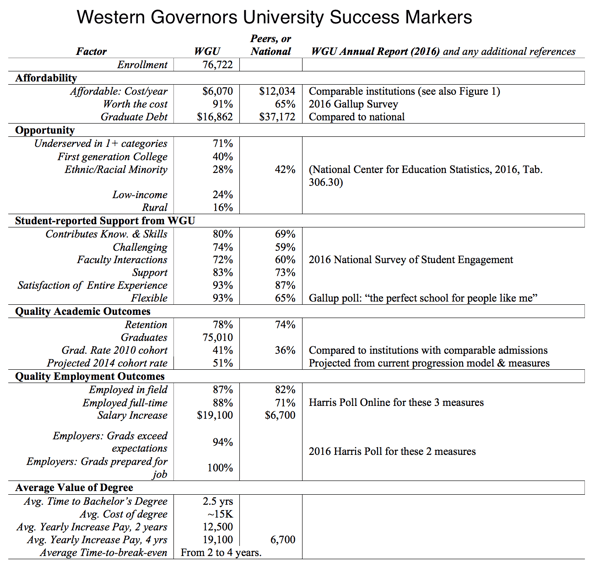Published on
Learning from WGU: Five Key Practices

Western Governors University (WGU) celebrated the 20th year of its founding in July 2017. WGU is the largest and oldest institution of higher learning that offers online, competency-based education (CBE), and our annual reports record the university’s success in enrollment growth, graduation, and low tuition, as well as its graduates’ relatively short time-to-break-even on tuition and successes with employers (WGU, 2016). Those accomplishments at summarized at the bottom of this article in the table WGU Success Markers.
In recognition of two decades’ experience in pioneering quality CBE at scale, let’s review five of WGU’s key practices—the institution’s hallmarks of a strong culture of student success:
- Provide High Value Programs
- Enable Mastery Learning
- Measure, Analyze and Support Learning
- Faculty Mentor Support for Success
- Continuously Challenge Your Institution to Improve Student Success
1. Provide High Value Programs
Educators wish that students would come to college for the love of learning. But to be honest, students come to college for many reasons, only one of which might be love of learning. The most common reason is to qualify or advance in a profession. WGU is built around the notion of providing students the value they’d like to have from a degree: earn a respected credential in chosen field, save money, finish fast, and master the competencies needed to succeed.
WGU has earned the respect of employers; as seen by 100 percent of employers surveyed agreeing that graduates are prepared for their job, and 94 percent agreeing that graduates exceed expectations. This respect comes in part from WGU’s work with employers to develop the competencies they want in a graduate and then using the CBE model to ensure that each student has mastered the competency before graduation.
As far as time, WGU mostly serves transfer students who have fewer credits needed to graduate and who are able through the model to achieve an average completion time of 2.5 years. With respect to cost, compared to other online schools, WGU’s tuition is below the 25th percentile (“IPEDS Report Center,” 2017) and averages about $15,000. In terms of paying off any loans, graduates increase their earnings within four years, 185 percent above the national average and more than enough to pay off any loans for tuition. Because WGU accommodates working students with online and a term 70 percent longer than average, students can continue working full time and suffer no loss of income while attending. As a measure of value, WGU students rate their satisfaction with the overall experience at 93 percent vs. 87 percent nationally, according to the National Survey of Student Engagement (WGU, 2016).
2. Enable Mastery Learning
In addition to meeting employment-derived competency standards (though the competency-based education model includes more than just standards) the model also includes mastery learning where students are given time and support to learn from their starting point until they have mastered the performance area. When a “final” exam or project is failed, it’s treated as “not yet passed” rather than a failure and faculty mentors and evaluators help students complete their learning. Exam retakes and project re-submissions are encouraged.
Why shouldn’t all students be given the time, support and opportunity to master what their future employers want? Anything else is not only inequitable, but also unproductive, akin to quitting the race after running 80 percent of the distance. WGU’s mastery learning is individual and optionally community-based. Group-based Mastery Learning has been shown to have an effect size as high as 1.0 (Ellis & Bond, 2016, loc. 2687), which speaks to a very significant positive impact for students.
3. Measure, Analyze, and Support Learning
Competency assessment produces a wealth of learning data in every course. At WGU, learning is measured at and below competency down to the level of learning objectives. Together with student demographic data, student and faculty interactions, and formative assessment, this pool of data supports deep analysis to support learning. Rather than being merely the stuff of unread reports, this analysis empowers faculty, curriculum designers, and technology developers to increasingly improve support for learning. Once the data collection is in place, institutions can innovate, compare A & B implementations, and perform learning analytics to create predictive risk models.
The most important aspect is to measure learning and supports for learning comprehensively and to invest in building and testing a practical theory of the institution. It’s worth mentioning David Merrill’s measures of effective strategies as goals for this analysis: effective learning that is efficient of students’ time and engaging of their interests (Merrill, 2012). Progress in any of these measures has an impact on the value of a program.
4. Faculty Mentor Support for Success
Faculty have always been a part of the WGU model. The shift to a dedicated faculty mentor assigned for the life of a student’s program coincided with steady increases in WGU’s key metrics (discussed in the following). The long-term relationship with each student allows a mentor to establish trust, learn each student’s strengths and challenges, and to work collaboratively with the student to overcome the challenges.
Though most WGU students are older, they appreciate their faculty, giving them high marks for interaction (72 percent versus 60 percent nationally) and support (83 percent versus 73 percent nationally) according to the 2016 NSSE survey (WGU, 2016).
5. Continuously Challenge Your Institution to Improve Student Success
The strategy to improving student success is to focus continuously on student success. One of the strongest levers of cultural change is to measure what matters. The Success Markers table below lists many of the detailed measures. Unifying the culture around student success, requires simpler measures overall, with detailed decomposition to departments so that all employees know their contribution to the success of the university’s mission. As a guide, measure what matters most and limit the number to 3 to 5. Actionable, current measures are better than lagging measures such as graduation rate. Suggested measures include retention, learning, progress to graduation, number of graduates this period, and percentage of very satisfied students versus dissatisfied, or the net promoter score (Reichheld & Markey, 2011). Set challenging goals each year, and review, reward and continuously manage to those metrics throughout the year.
Conclusion
By taking a student-centric, employer-focused and supportive approach, reinforced by analyzing, studying, measuring and rewarding student success, WGU has evolved over its 20-year history to demonstrably support 80,000 graduates who value their competencies and degrees which in turn are valued by their employers. They have achieved the goal they came to achieve, qualify or advance in their chosen fields, and in so doing, have benefited themselves, their families, their employers and society.
– – – –
References
Ellis, A. K., & Bond, J. B. (2016). Research on Educational Innovations (5 edition). Routledge.
IPEDS Report Center. (2017). Retrieved August 16, 2017, from https://nces.ed.gov/ipeds/datacenter/institutionlist.aspx?stepId=1
Merrill, M. D. (2012). First Principles of Instruction (1 edition). San Francisco, CA: Pfeiffer.
National Center for Education Statistics. (2016). Digest of Education Statistics. Retrieved from https://nces.ed.gov/programs/digest/d16/tables/dt16_326.30.asp?current=yes
Reichheld, F., & Markey, R. (2011). The Ultimate Question 2.0 (Revised and Expanded Edition): How Net Promoter Companies Thrive in a Customer-Driven World (Rev Exp edition). Boston, Mass: Harvard Business Review Press.
WGU. (2016). WGU Annual Report. Salt Lake CIty, UT: Western Governors University. Retrieved from https://www.wgu.edu/about_WGU/annual_report
Author Perspective: Analyst



